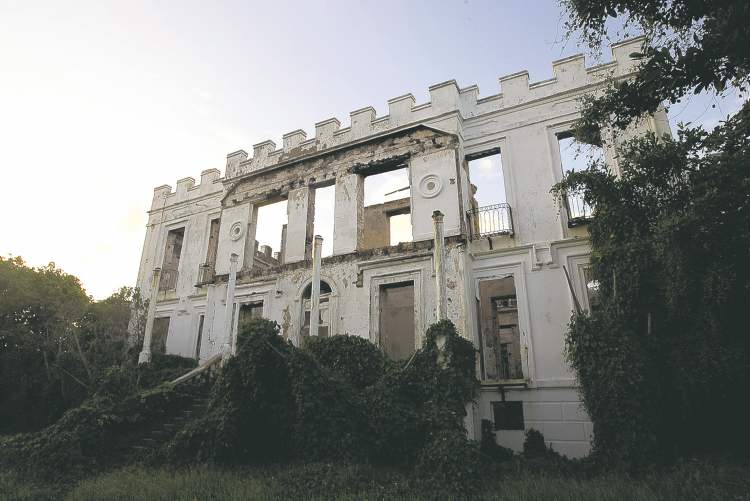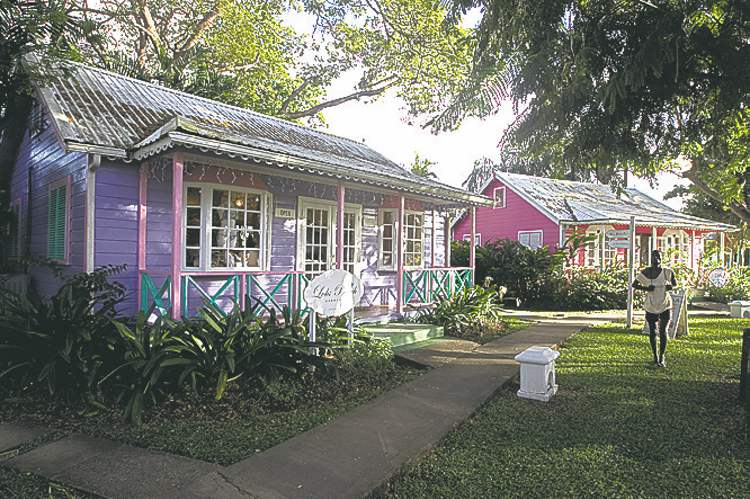Beyond Barbados’ beaches
Historical sites offer fascinating look at colonial past
Advertisement
Read this article for free:
or
Already have an account? Log in here »
To continue reading, please subscribe:
Monthly Digital Subscription
$1 per week for 24 weeks*
- Enjoy unlimited reading on winnipegfreepress.com
- Read the E-Edition, our digital replica newspaper
- Access News Break, our award-winning app
- Play interactive puzzles
*Billed as $4.00 plus GST every four weeks. After 24 weeks, price increases to the regular rate of $19.00 plus GST every four weeks. Offer available to new and qualified returning subscribers only. Cancel any time.
Monthly Digital Subscription
$4.75/week*
- Enjoy unlimited reading on winnipegfreepress.com
- Read the E-Edition, our digital replica newspaper
- Access News Break, our award-winning app
- Play interactive puzzles
*Billed as $19 plus GST every four weeks. Cancel any time.
To continue reading, please subscribe:
Add Winnipeg Free Press access to your Brandon Sun subscription for only
$1 for the first 4 weeks*
*$1 will be added to your next bill. After your 4 weeks access is complete your rate will increase by $0.00 a X percent off the regular rate.
Read unlimited articles for free today:
or
Already have an account? Log in here »
Hey there, time traveller!
This article was published 12/03/2012 (4931 days ago), so information in it may no longer be current.
It was the sinister skull-and-crossbones carving that made the tombstone so conspicuous.
Moss-covered and cracking, the tombstone was wedged among hundreds of others, many of them only centimetres apart, in a crowded 357-year-old Jewish cemetery crammed into bustling downtown Bridgetown, the seaside capital of Barbados.
Were there Jewish pirates in Barbados? It’s easy enough to imagine. After all, there were Jewish pirates on other Caribbean islands.

It’s true it is possible to enjoy Barbados without ever leaving the beach. From bathing and surfing to shopping and golf, there is more than enough to occupy any visitor to the most easterly of the Caribbean islands.
But for the adventurous traveller with an interest in history, there is much more to be discovered.
This country’s wealth was created by African slaves, European landowners and Jews seeking religious freedom. They have all left their marks here, making for some fascinating stories.
According to Celso H. Brewster, manager of Nidhe Israel museum beside the cemetery, the skulls and crossbones don’t indicate the resting places of pirates.
“That’s what I heard too, until I saw a child’s grave with the same symbol,” he explains. “Obviously there is no way a child would be a pirate!” He believes a more likely explanation is that the symbol was a caution to others not to open the grave of someone who had perished from disease.
The cemetery belongs to the Nidhe Israel Synagogue, located on Synagogue Lane, a few blocks away from the Parliament buildings. It is one of the two oldest synagogues in the Western Hemisphere. The other is in Curaßao, and there is fierce debate over which is older.
The original Bridgetown synagogue was built around 1654 by Jews fleeing threats of the Inquisition in Portuguese-controlled Brazil. The building was destroyed by a hurricane in 1831 and rebuilt two years later. Even though they had been forced to convert to Christianity — they were mostly “New Christians” or “Conversos” — many of these Jews had practised their faith in secret in Brazil.
With them, they brought sugar cane to Barbados and helped to kick-start the Sugar and Rum Revolution, quickly making the island at the time “the richest spote of land in the worlde,” as it was widely known in 17th-century Britain.
Just south of the synagogue is Swan Street, known as “Jew Street” in the 17th century for the number of Jewish merchants who lived and worked there. Those merchants are long gone, but the street is a thriving pedestrian mall with everything from clothing stores and restaurants to street vendors hawking shoes and bootleg movies on DVD.
All over Bridgetown are prominent signs of the colonial past. Barbados was an English (then British) colony from 1627 until gaining independence in 1966.
Just south of the synagogue, on Broad Street close to the waterfront, are the stately Parliament buildings. The two Gothic structures, home to the House of Assembly and the Senate, were completed in 1874.
Almost 70 years before that, to commemorate victory of the British Royal Navy at the Battle of Trafalgar in 1805, a statue of Lord Nelson was erected in 1813 just a few metres south, between Broad Street and Wharf Road. Locals boast that it predates the more famous Nelson’s Column in London by 30 years. In fact, the location of the Barbados statue was called Trafalgar Square until 1999, when it was renamed National Heroes Square.
The Emancipation Statue, commonly called the Bussa statue, was erected in honour of the leader of the 1816 slave revolt. Bussa is one of Barbados’ national heroes. The statue depicts a black slave breaking free of his chains and brings home the knowledge that slavery was the engine that drove the economy from the early 17th century until emancipation in 1824.
One remnant of the plantation culture that continued even after the abolition of slavery is the Chattel House, a significant aspect of Barbadian architecture. Made of wood, chattel houses were traditionally built by plantation workers, most of them former slaves, on wooden blocks, instead of a buried foundation. Another defining feature of these houses is the bright colours in which they are painted, each having its own combination, mostly of reds, pinks, yellows and bright greens.
In Holetown, site of the country’s first settlement in 1625, on the west coast north of Bridgetown, there is Chattel Village, where this display of colours is the main attraction. The small cluster of houses is used for souvenir stands, craft shops and restaurants built to lure tourists.
A 45-minute drive North of Bridgetown near Highway 2, at Cherry Tree Hill in the parish of St. Peter, is a Great House that, perhaps more than most, gives visitors a taste of the colonial history and plantation culture. All that, and a shot of rum, too.
It is St. Nicholas Abbey, a whitewashed, stately mansion that sits on one of the oldest operating sugar-cane plantations on the island, with an estate of more than 100 hectares.
Built in 1658, it is said to be one of only three remaining 17th-century Jacobean-architecture mansions in the Western Hemisphere. Another is at Drax Hall in the parish of St. George to the south, just off Highway 4. The third is Bacon’s Castle in the U.S. state of Virginia.

Much of the plantation’s 17th-century features have been preserved or restored. Beside the Great House, there is a museum where St. Nicholas Abbey Barbados Rum, made at the plantation, can be sampled. There is also a 19th-century steam mill where visitors can watch sugar cane being crushed to make sugar, molasses and rum.
Sam Lord, a famous Englishman from the 19th century. was said to be a pirate, but there is some dispute regarding this. Whatever the true story, Sam Lord became wealthy from his operations and built himself a remarkable mansion on rocks close to the sea, off the southeast coast of St. Philip.
Sam Lord’s Castle was turned into a hotel of the same name, but it was gutted by fire in 2010. The remains are still there, watched over by birds and stray dogs, and a hermit selling coconuts on the beach who thinks the demise of the castle “is a really, really sad thing, you know!”
Perhaps the castle will one day be restored and welcome visitors once again. In the meantime, for travellers interested in this country’s fascinating colonial history, there is no shortage of places to visit and things to see.
— Postmedia News
IF YOU GO
The Nidhe Israel synagogue is open to visitors Mondays to Fridays and admission is free. It is open for Friday night services from Dec. 15 to March 15, the tourism high season. It is open for viewing with no admission charge all year from 9 a.m. to 4 p.m. The museum is open Mondays to Fridays from 9 a.m. to 4 p.m. and by appointment only on weekends. Admission is US$12.50, half price for children.
Chattel Village is located in Holetown, north of Bridgetown on Highway 1, next to the West Mall Shopping Centre.
St. Nicholas Abbey is open from 10 a.m. to 3:30 p.m. Sunday to Friday. Admission is about $17 Cdn.
To get around, visitors can rent a car for about $65 Cdn (for economy size). To drive in Barbados, visitors need a local driving permit, which can be obtained by showing a valid driver’s licence and paying $10 Bbd. Driving is on the left and most roads are very narrow and winding.
For public transit, buses or large vans called ZRs travel to or from Bridgetown — all bus stops are marked “to City” or “from City.” Fare is $2 Bbd one way.
Business hours are generally from 8:30 a.m. to 4:30 p.m. weekdays.

